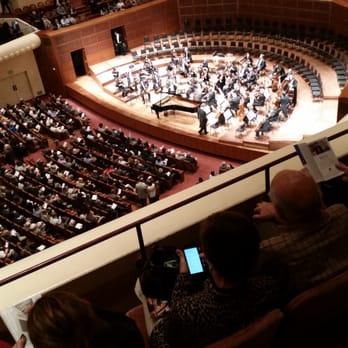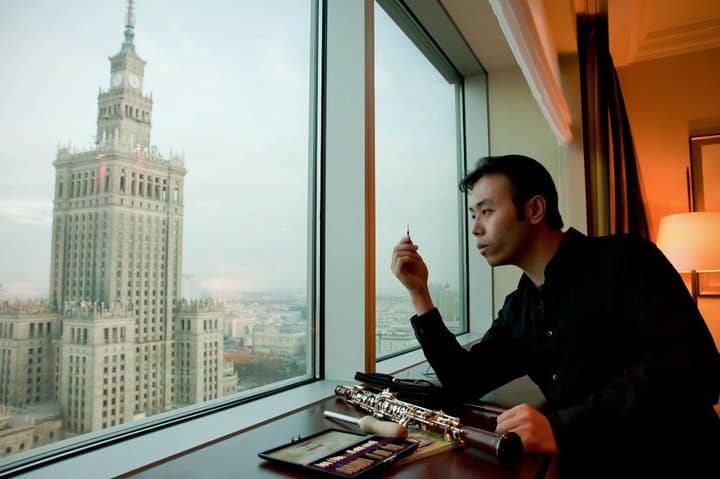What’s wrong with US orchestras today?
NewsA helpful laundry list from ArtsJournal’s Doug McLennan:
a structure driven by the need to raise ever-larger budgets,
a business model that no longer adequately services artistic needs
a stakeholder culture at war with itself,
a sclerotic backstage culture built for institutional production that increasingly doesn’t match a front-of-house culture richly served by competing offerings,
a star-driven music director model that no longer matches the orchestra’s artistic needs as they have evolved beyond the podium,
a culture that many young musicians feel is not enough personally creative or fulfilling,
inflexible rules and procedures that govern the work of the institution,
a failure to reconceive the structure of a top-down proprietary model into something that more accurately serves the mission of an orchestra (tech companies have figured this out for their industry, so why haven’t arts organizations?)
To which we might add:
a lack of executive entrepreneurship
a loss of music director imagination
a dependence on regular visitors
a fear to trust youth.
Read Doug’s analysis here.






And again, always list of problems, no solutions.
Did you actually read this story??? The author tries to put the situation of orchestras in context with the larger culture and writes about a possible way to do that. The “laundry list” is a very small part of it.
Nothing is wrong.
Classical music is doing well.
In every major city, tens of thousands of people attend performances every week. There’s often a ballet, an opera, and a symphony, all doing multiple shows a week.
Musicians, dancers, and singers are all well paid. They have never been paid more.
Why the constant warnings of a doomsday and demands for change? People who do this usually have a hidden agenda which does not coincide with the happiness of the thousands and thousands of people who attend classical performances every week.
Agreed.
“The death of classical music is perhaps its oldest continuing tradition.” – Charles Rosen
Honestly not sure if this is meant to be ironic.
in this era of Tik-Tok attention spans and selfie moments, McLennan’s essay flouting the idea of “cut to the chase” doesn’t help matters. Okay, maybe I’m not intellectual enough, but I found my eyes starting to blur as I was trying to figure out his take on politics in terms of both culture and government-institutions.
S.F. Symphony has already given three outstanding Mahler performances this season – all of which were well attended: M5 with Dudamel; M7 with Tilson-Thomas (the best one I think he’s given thus far), and M2 with Salonen. Next month has a program that has the Prokofiev 2nd piano concerto and Rachmaninoff’s “Symphonic Dances”. I’d say they’re doing just fine at this point.
Mahler is the new Beethoven, sooooo lazy…..
I realize this comment is not the entire answer and reflects my age but in 1959 the US Big 5 were led by Szell, Reiner, Munch, Ormandy and Bernstein. Does anyone seriously think that any of the current crop, under the age of 80, would be leading one of those orchestras in 1959? Expenses were always a challenge and the solution was often a benefactor(s) making up the shortfall. Similarly, not all MDs were as adept behind the scenes as on the podium. That said virtually every concert was inspired. Perhaps if today’s conductors were as well trained as their “ancient” predecessors, and had the same opportunities to learn their craft in the provinces, the future would be brighter.
We find this article very well written and insightful, but lacking more examples that we can therefore offer here for consideration.
One famous music director of a famous US orchestra, the Italian Stallion, had one major cultural accomplishment to be boastful of: to have kept the original N-word in a Verdi libretto. That was his contribution to US culture in the past year as broadcasted by his pet Chicago and Italian journalists. He also, we learned on this site, want us to believe that contemporary music makes milk go bad (yes, you read it correctly). That says a lot, right?
One not-so-famous President of a famous US orchestra, Alexander the Great, does not appear to be focused on developing a compelling vision for his institution. He is almost exclusively focused on “counting beans” and making sure the MD’s time in town is … gratifying , and hires staff to fulfill that purpose (and yes, the MD time is apparently very gratifying as ample chunks of his afternoon and w/e schedule are “filled” to take advantage of the low hanging fruit offered by the President); and, we must assume, he likely does so with the implicit or explicit knowledge and support of the Chair of the Board. When the MD is in town, the President’s primary concern is to be punctual downstairs to greet and pay servile homage to the MD. That has been his contribution to US culture, and says perhaps even more.
One VP for Artistic Planning (another Italian) came up with an ill-conceived and ill-timed ‘Russian blast’ season, for the lack of a better description, because the Italian MD said so. She has engineered year after year of trite, repetitive and sterile programming that has resulted in audiences running for the exits and in halls that not even a Thielemann can fill. What else shall we add ..
Oh yes … The orchestra is the only bright spot: they have co-opted the MD on their picket lines to extract more value out of donors who ultimately pay their salaries, and perfected a method of blind auditions that is the pride of the western hemisphere so that they don’t even have to worry about family members winning coveted jobs; as a result of their superb performances, they consistently receive good reviews signed by Hedy Weiss and Valerio Cappelli, the only journalists whose reviews they seem to accept as authoritative.
Different orchestras, different cities, have differing issues. I will say that, in creating the first 50 state project without buy-ins from orchestras, I have been communicating with executive directors, artistic directors, conductors, and they all share the common goals of wanting audiences to return. I created the commissioning model of no buy-ins simply from time and effort raising the composer’s fee and copying costs (Peter Boyer in this case). It is an effort that, moving forward, needs to be shared by performers, just in my own personal opinion. Budgets for paying composers for new projects is not so easy for many orchestras. I believe that our help as artists to cultivate new repertoire can work hand in hand with orchestras. Regarding star status, yes. Coming out of Covid silence, the emphasis is slowly becoming apparent that it takes grassroot efforts to make this happen. I tell composers and conductors from the get go, that the commissioning projects is not about them nor me, but about working together to make things happen, across the board, in this case, unifying the states. It will take time, trial and error, trying new tactics, to accomplish the things you state. In the end, it is about everyone working together, and removing the focus on the ‘I’ and ‘me’. We will be remembered for our legacies. I do believe orchestras are finding ways to make their organizations relevant in this new normal, and how music is more important now than before to keep us going. Music needs to evolve continually.
That’s the thing. There is no new normal. Humans haven’t changed. What humans respond to and what touches them hasn’t changed.
Anything contrary to this won’t last.
+ Boards of Directors filled with people who just want their name on lists, and won’t work to grow the the organization.
Has anyone read the 1935 Fortune Magazine article, Symphony Finance? Read it, and you’ll find out that there is nothing new about the problems face by American orchestras.
“The modern orchestra contract is breathtakingly inflexible in what it will and won’t allow…”
The solution might be to go down a level and coordinate the streaming of youth orchestra performances and competitions.
Americans will pay good money to watch amateurs sweat.
None of this even appears relevant. There is only one problem; not enough customers in some of the small markets. Possible solutions are being implemented, mostly in programming and education. Give them 5 years and see what happens. For an orchestra fan where I live, it’s a great time; stellar performances for humble ticket prices.
Budgets, business models, stakeholders??…and I thought orchestras were just there to play music!
Many problems: unions; lack of significant public support; huge management costs; incompetent artistic directors more interested in programming unknown and uninteresting pieces by BIPOC or women just because they are by women or BIPOC than providing what the public demands (same goes for conductors… They have to look right); high costs of tickets; poor middle & high school education…
“a culture that many young musicians feel is not enough personally creative or fulfilling,
inflexible rules and procedures that govern the work of the institution” – musicians wanting personal creativity should not join orchestras, period – that’s a paradox. Without rules and procedures (particularly with so many large and sensitive egos in one place) comes chaos.
“a failure to reconceive the structure of a top-down proprietary model into something that more accurately serves the mission of an orchestra (tech companies have figured this out for their industry, so why haven’t arts organizations?)” – So put more ping pong tables and sleep pods backstage?? Does this guy think Steve Jobs, Jeff Bezos and Mark Zuckerberg were / are nice people who were willing to throw away the top-down approach? Oyyy vayyy
It’s the musicians. The musicians are what’s wrong with US orchestras today.
Sadly, your comment is not as ironic as you may think.
PLEASE elaborate!
I would add that music education for all children in or out of school is imperative for the arts in our society now and in the future.
Sorry, but orchestra musicians know that outreach programs are a big waste of time.
She was speaking of music education
programs for children, not symphony outreach programs specifically. The quality (and quantity) of music education in American
schools has declined drastically. I should say the quality of university music education has also declined. Fewer music teachers, (especially well educated ones), fewer parents willing to pay for the arts, look at the results. When I was a school kid in the early 60s, most of my friends started on an instrument in elementary school. That is the exception nowadays.
Add to the list: most orchestral music written in the last century is crap.
He’s right, there are some big problems.
However the article is full of tenuous assertions which then go on to prop up grander ideas around race and culture which are no more than intellectual constructs.
For example, the idea that Florence Price was denied ‘a seat at the table’ not only because she was a woman and black but also because her music looked backwards and classical music has been wrongly obsessed with progress and ‘excitement in the future’ is the sort of dubious post-rationalisation of failure which shifts blame according to need. It also contains the progressive sub text that – her failure is our (classical music’s) collective failure for not understanding what we should have been interested in. Good luck changing that.
As for the rest, more of the same hit and miss assertions.
It is always interesting to see how much time and intelligence can be invested in engineered speculation.
And, not enough overtures. Audiences like them but they’ve been pushed off the table by other priorities.